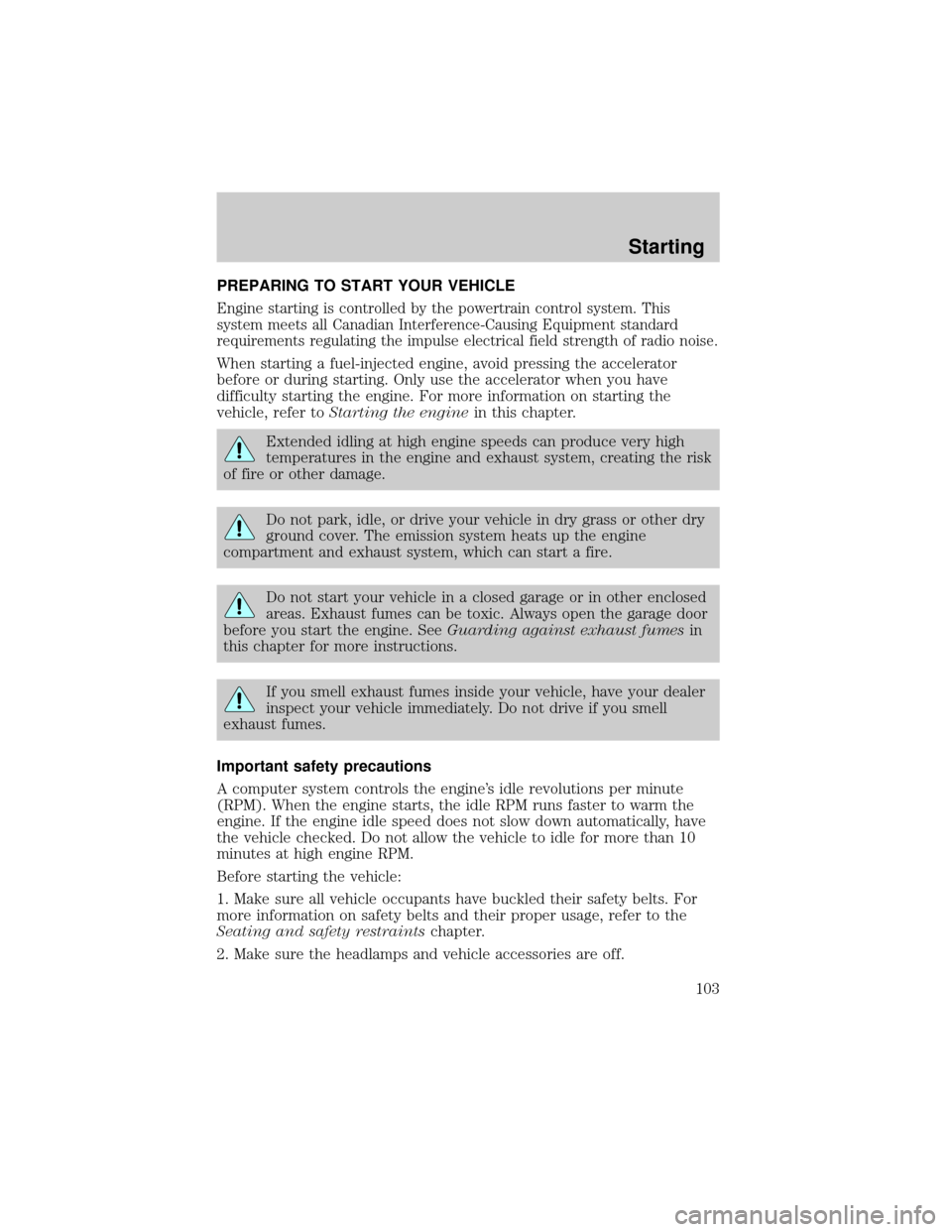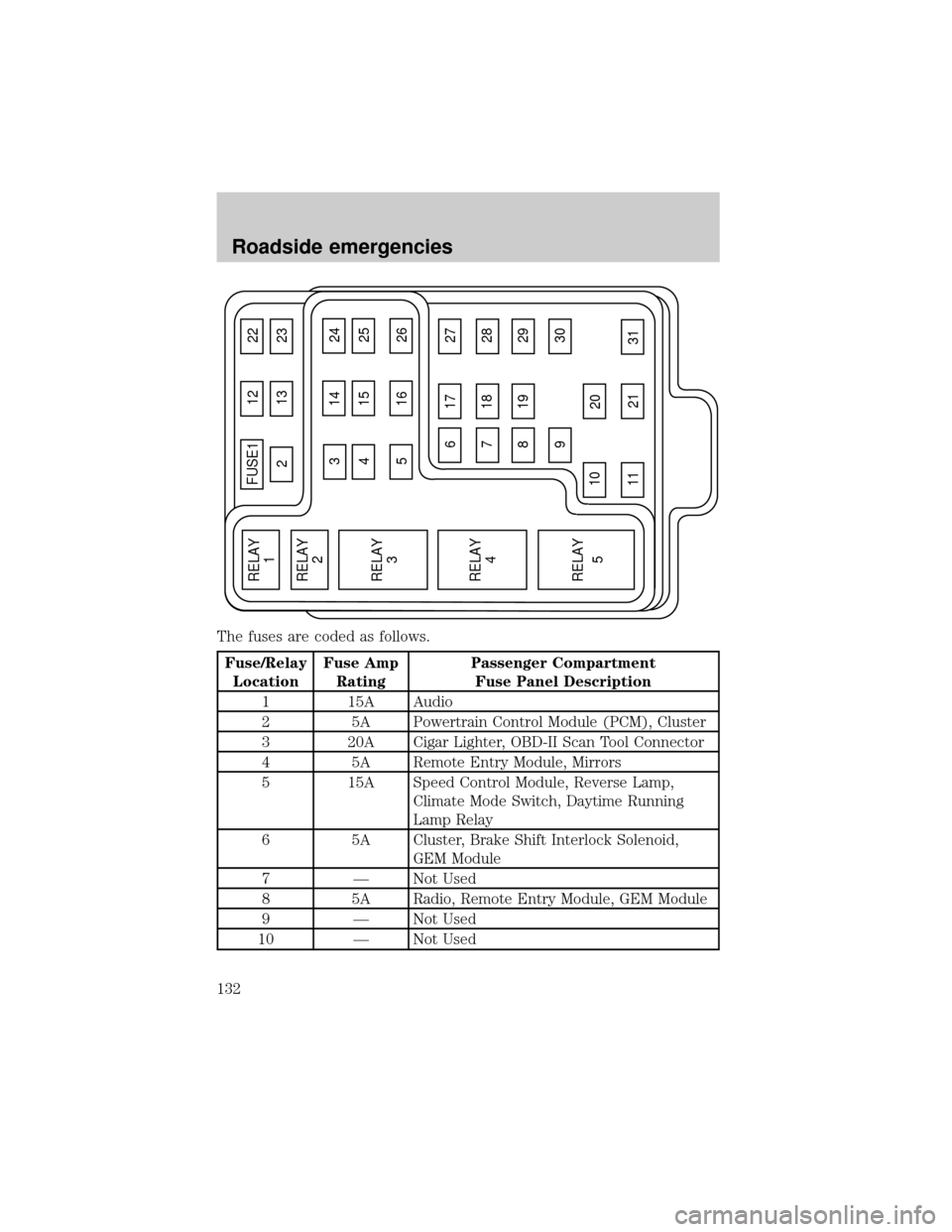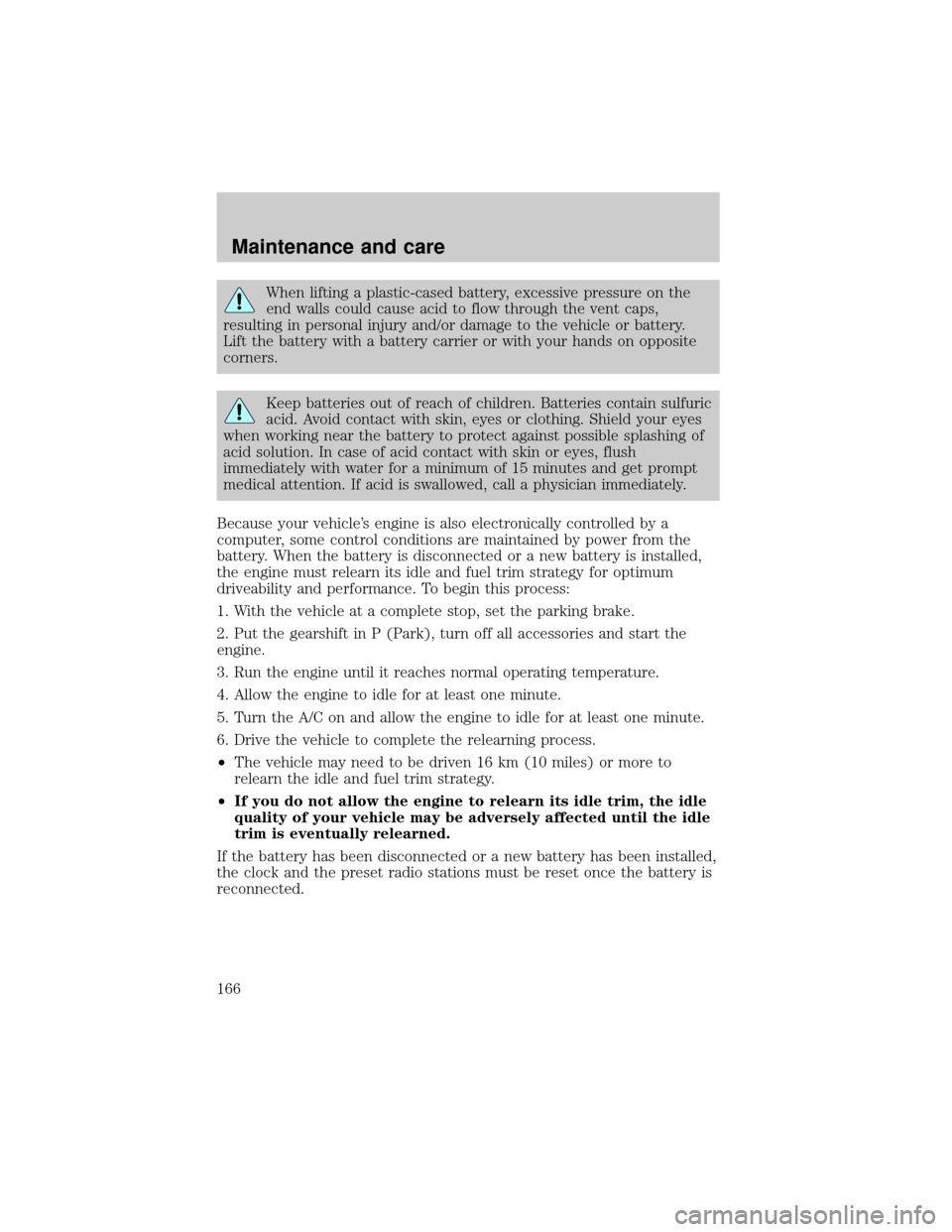2001 FORD F150 radio
[x] Cancel search: radioPage 68 of 224

Changes or modifications not expressly approved by the party
responsible for compliance could void the user's authority to
operate the equipment.
Replacing the battery
The remote transmitter is powered by one coin type three-volt lithium
battery CR2032 or equivalent. Typical operating range will allow you to
be up to 10 meters (33 feet) away from your vehicle. A decrease in
operating range can be caused by:
²weather conditions
²nearby radio towers
²structures around the vehicle
²other vehicles parked next to the vehicle
To replace the battery:
1. Twist a thin coin between the two
halves of the transmitter near the
key ring. DO NOT TAKE THE
FRONT PART OF THE
TRANSMITTER APART.
2. Place the positive (+) side of new
battery in the same orientation.
Refer to the diagram inside the
transmitter unit.
3. Snap the two halves back
together.
Replacement of the battery willnotcause the remote transmitter to
become deprogrammed from your vehicle. The remote transmitter should
operate normally after battery replacement.
Controls and features
68
Page 103 of 224

PREPARING TO START YOUR VEHICLE
Engine starting is controlled by the powertrain control system. This
system meets all Canadian Interference-Causing Equipment standard
requirements regulating the impulse electrical field strength of radio noise.
When starting a fuel-injected engine, avoid pressing the accelerator
before or during starting. Only use the accelerator when you have
difficulty starting the engine. For more information on starting the
vehicle, refer toStarting the enginein this chapter.
Extended idling at high engine speeds can produce very high
temperatures in the engine and exhaust system, creating the risk
of fire or other damage.
Do not park, idle, or drive your vehicle in dry grass or other dry
ground cover. The emission system heats up the engine
compartment and exhaust system, which can start a fire.
Do not start your vehicle in a closed garage or in other enclosed
areas. Exhaust fumes can be toxic. Always open the garage door
before you start the engine. SeeGuarding against exhaust fumesin
this chapter for more instructions.
If you smell exhaust fumes inside your vehicle, have your dealer
inspect your vehicle immediately. Do not drive if you smell
exhaust fumes.
Important safety precautions
A computer system controls the engine's idle revolutions per minute
(RPM). When the engine starts, the idle RPM runs faster to warm the
engine. If the engine idle speed does not slow down automatically, have
the vehicle checked. Do not allow the vehicle to idle for more than 10
minutes at high engine RPM.
Before starting the vehicle:
1. Make sure all vehicle occupants have buckled their safety belts. For
more information on safety belts and their proper usage, refer to the
Seating and safety restraintschapter.
2. Make sure the headlamps and vehicle accessories are off.
Starting
103
Page 132 of 224

The fuses are coded as follows.
Fuse/Relay
LocationFuse Amp
RatingPassenger Compartment
Fuse Panel Description
1 15A Audio
2 5A Powertrain Control Module (PCM), Cluster
3 20A Cigar Lighter, OBD-II Scan Tool Connector
4 5A Remote Entry Module, Mirrors
5 15A Speed Control Module, Reverse Lamp,
Climate Mode Switch, Daytime Running
Lamp Relay
6 5A Cluster, Brake Shift Interlock Solenoid,
GEM Module
7 Ð Not Used
8 5A Radio, Remote Entry Module, GEM Module
9 Ð Not Used
10 Ð Not Used
FUSE1 12 22
21323
617 27
718 28
819 29
930
20
31 21 11 10
RELAY
5 RELAY
4 RELAY
3 RELAY
2 RELAY
1
31424
41525
51626
Roadside emergencies
132
Page 166 of 224

When lifting a plastic-cased battery, excessive pressure on the
end walls could cause acid to flow through the vent caps,
resulting in personal injury and/or damage to the vehicle or battery.
Lift the battery with a battery carrier or with your hands on opposite
corners.
Keep batteries out of reach of children. Batteries contain sulfuric
acid. Avoid contact with skin, eyes or clothing. Shield your eyes
when working near the battery to protect against possible splashing of
acid solution. In case of acid contact with skin or eyes, flush
immediately with water for a minimum of 15 minutes and get prompt
medical attention. If acid is swallowed, call a physician immediately.
Because your vehicle's engine is also electronically controlled by a
computer, some control conditions are maintained by power from the
battery. When the battery is disconnected or a new battery is installed,
the engine must relearn its idle and fuel trim strategy for optimum
driveability and performance. To begin this process:
1. With the vehicle at a complete stop, set the parking brake.
2. Put the gearshift in P (Park), turn off all accessories and start the
engine.
3. Run the engine until it reaches normal operating temperature.
4. Allow the engine to idle for at least one minute.
5. Turn the A/C on and allow the engine to idle for at least one minute.
6. Drive the vehicle to complete the relearning process.
²The vehicle may need to be driven 16 km (10 miles) or more to
relearn the idle and fuel trim strategy.
²If you do not allow the engine to relearn its idle trim, the idle
quality of your vehicle may be adversely affected until the idle
trim is eventually relearned.
If the battery has been disconnected or a new battery has been installed,
the clock and the preset radio stations must be reset once the battery is
reconnected.
Maintenance and care
166
Page 213 of 224

Hood deflectors
Leather wrapped steering wheel
Locking gas cap
Molded splash guards
Molded vinyl floor mats
Rally combination bar
Rear window deflector
Removable tailgate lock
Skid plates
Side window air deflectors
Spare tire lock
Step bumpers
Tailgate covers, diamond plate
Tonneau covers (hard, foldable)
Tonneau covers (hard, one piece)
Tonneau covers (soft)
Truck cover
Underbody vehicle lighting
Universal floor mats
Wheels
For maximum vehicle performance, keep the following information in
mind when adding accessories or equipment to your vehicle:
²When adding accessories, equipment, passengers and luggage to your
vehicle, do not exceed the total weight capacity of the vehicle or of
the front or rear axle (GVWR or GAWR as indicated on the Safety
compliance certification label). Consult your dealer for specific weight
information.
²
The Federal Communications Commission (FCC) and Canadian Radio
Telecommunications Commission (CRTC) regulate the use of mobile
communications systems - such as two-way radios, telephones and theft
alarms - that are equipped with radio transmitters. Any such equipment
installed in your vehicle should comply with FCC or CRTC regulations
and should be installed only by a qualified service technician.
Customer assistance
213
Page 216 of 224

Accessory delay ..........................59
Air bag supplemental
restraint system ..........................90
and child safety seats ..............92
description ................................90
disposal ......................................94
driver air bag ............................92
indicator light ........................9,94
operation ...................................92
passenger air bag .....................92
Air cleaner filter ................167,194
Air conditioning ..........................43
Ambulance packages ....................3
Antifreeze
(see Engine coolant) ................154
Anti-lock brake system
(see Brakes) .......................107,108
Anti-theft system
warning light .............................11
Armrests ......................................79
Audio system (see Radio) .........21
Automatic transmission
driving an automatic
overdrive .................................113
fluid, adding ............................161
fluid, checking ........................161
fluid, refill capacities ..............194
fluid, specification ..................199
Auxiliary power point .................20
Axle
lubricant specifications ...197,199
refill capacities ........................194
traction lok ..............................110
Battery .......................................165
acid, treating emergencies .....165
charging system
warning light .............................11
jumping a disabled battery ....142
maintenance-free ....................165
replacement, specifications ...194
servicing ..................................165
voltage gauge ............................15Bed extender ..............................62
Belt minder .................................86
Brakes ........................................107
anti-lock ............................107,108
anti-lock brake system
(ABS) warning light ..........10,108
brake warning light ..................10
fluid, checking and adding ....153
fluid, refill capacities ..............194
fluid, specifications ..........197,199
lubricant specifications ...197,199
parking ....................................109
pedals (see Power
adjustable foot pedals) ............19
shift interlock ..........................112
Break-in period .............................3
Capacities for refilling fluids ....194
Cassette tape player ...................29
CD changer .................................39
Certification Label ....................201
Child safety restraints ................95
child safety belts ......................95
Child safety seats ........................96
attaching with tether straps ..101
in front seat ..............................97
in rear seat .........................97,100
Cleaning your vehicle ...............188
engine compartment ..............191
exterior .............................189,190
exterior lamps .........................191
instrument panel ....................192
instrument panel lens ............192
interior .....................................192
plastic parts ............................191
safety belts ..............................193
washing ....................................189
waxing .....................................190
wheels ......................................190
wiper blades ............................192
Climate control (see Air
conditioning or Heating) ............43
Clock .......................................29,38
Index
216
Page 219 of 224

daytime running light ...............17
fog lamps ...................................18
headlamps .................................17
headlamps, flash to pass ..........17
instrument panel, dimming .....18
interior lamps ......................56,57
replacing
bulbs ............183,184,185,186,187
Lane change indicator
(see Turn signal) ........................46
Lights, warning and indicator ......8
air bag ..........................................9
anti-lock brakes (ABS) .....10,108
anti-theft ...................................11
brake ..........................................10
charging system ........................11
check coolant ............................11
cruise indicator .........................12
door ajar ....................................12
engine oil pressure ...................11
high beam .................................11
low fuel ........................................8
safety belt .................................10
service engine soon ....................8
speed control ............................50
turn signal indicator .................10
Load limits .................................120
GAWR ......................................120
GVWR ......................................120
trailer towing ..........................120
Loading instructions .................121
Locks
autolock .....................................70
childproof ..................................59
doors ..........................................59
Lubricant specifications ....197,199
Lumbar support, seats ...............76
Mirrors
fold away ...................................61
side view mirrors (power) .......60
Moon roof ....................................57
Motorcraft parts .................178,194Octane rating ............................176
Odometer .....................................15
Oil (see Engine oil) ..................150
Overdrive .....................................52
Panic alarm feature, remote
entry system ................................67
Parking brake ............................109
Parts (see Motorcraft parts) ....194
Pedals (see Power adjustable
foot pedals) .................................19
Power adjustable foot pedals .....19
Power distribution box
(see Fuses) ...............................134
Power door locks ...................59,70
Power steering ..........................110
fluid, checking and adding ....160
fluid, refill capacity ................194
fluid, specifications ..........197,199
Preparing to
drive your vehicle .....................111
Radio ............................................21
Relays ........................................130
Remote entry system ............66,67
illuminated entry ......................71
locking/unlocking doors ...........67
panic alarm ...............................67
replacement/additional
transmitters ..........................69,70
replacing the batteries .............68
Safety belts (see Safety
restraints) ...........13,79,80,81,82,83
Safety defects, reporting ..........215
Safety restraints ......79,80,81,82,83
belt minder ...............................86
cleaning the safety belts ...89,193
extension assembly ..................85
for adults .........................80,81,82
for children ..........................94,95
lap belt ......................................84
warning light
and chime ...................10,12,13,85
Safety seats for children ............96
Index
219